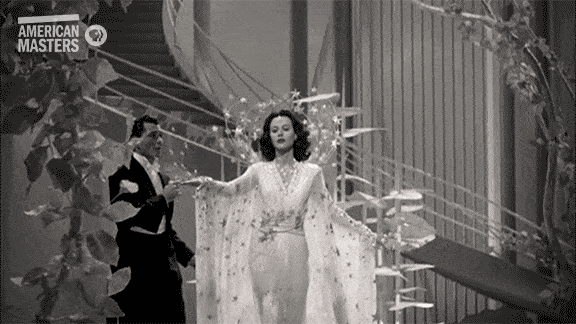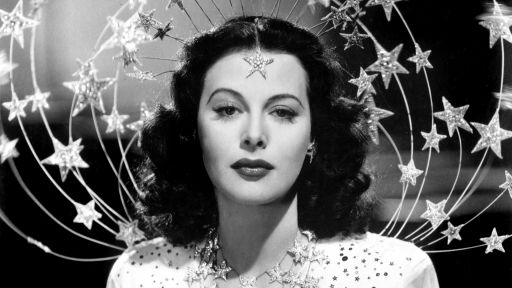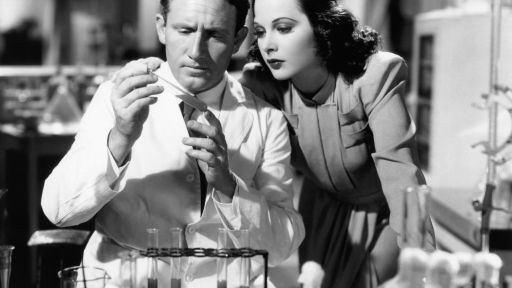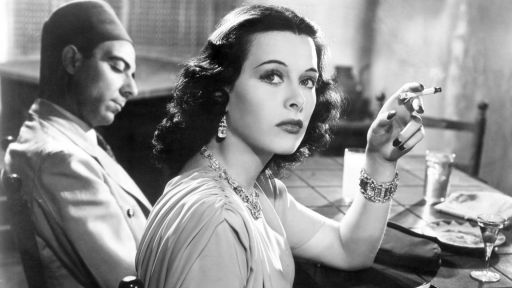by Elisa Lichtenbaum
Hollywood star Hedy Lamarr was –for a time– known as the most beautiful woman in the world. She graced the cover of every magazine, and inspired women everywhere to part their hair down the middle and darken their makeup to achieve her iconic look.
But the Austrian-born starlet was also an inventor whose pioneering work — a frequency-hopping communications system created to help defeat the Nazis during World War II — is the basis for today’s WiFi, GPS and Bluetooth technologies. Lamarr’s beauty stood in the way of her getting the credit she deserved for this groundbreaking invention.
Here are 7 fascinating facts about this iconic movie star-turned-inventor.
1) Her first film was banned by the Pope and Hitler.
Lamarr soared to international stardom at age 18 when she appeared in the 1933 Czech film Ecstasy. While some critics today have declared Ecstasy an arthouse classic, its nudity and sexual nature were considered scandalous when it was originally released. The Pope denounced the film in the Vatican newspaper, the Catholic Legion of Decency condemned it, and Hitler banned it in Germany – because Lamarr (then Hedy Kiesler) was Jewish.
2) She was the model for Snow White and Catwoman.
Ink-black tresses. Cherry-red lips. Porcelain doll complexion. Lamarr’s beauty was simultaneously classic and exotic, making her the perfect model for Disney’s Snow White. Lamarr was also the inspiration for Catwoman in the original Batman comics. More recently, actress Anne Hathaway told The Washington Post that she studied Lamarr’s voice while preparing for the role of Catwoman in the 2012 film The Dark Knight Rises.
3) She’s a rock star at Google.
Google paid tribute to Lamarr in a smart and stylish 2015 Google Doodle celebrating her 101st birthday. According to Jennifer Hom, who designed the Doodle, Lamarr has “a kind of mythical status” at Google. “Within the nerd community at Google, Hedy Lamarr is a beloved figure,” she remarked in a blog. “We love highlighting stories about women’s achievements in science and technology. When the story involves a 1940s Hollywood star-turned-inventor who helped develop technologies we use with our smartphones today, we have to share it with the world.”
4) She’s in the Mel Brooks film Blazing Saddles…sort of.
Forget the campfire flatulence. One of our favorite moments in Mel Brooks’ uproarious comedy Blazing Saddles is when Harvey Korman says, “It’s not Hedy, it’s Hedley. Hedley Lamarr.” Brooks, the subject of the popular American Masters documentary Mel Brooks: Make a Noise, named Korman’s conniving character Hedley Lamarr as an affectionate tongue-in-cheek homage to the actress – but she was not amused. She sued Warner Bros. and was awarded a small out-of-court settlement and an apology from Brooks for “almost using her name.” Don’t miss Brooks’ interview in Bombshell.
5) She received a patent for her invention.
Lamarr teamed up with avant-garde composer George Antheil (Ballet Mécanique) to create her frequency-hopping technology, basing its functionality on player pianos. They received a patent from the National Inventors Council for their idea in 1942 and shared it with the Navy — but Lamarr was told to sell kisses for war bonds instead. Their technology was used decades later during the Cuban Missile Crisis, but they never earned any money from it as the patent had expired.
6) She produced her own movies.
Lamarr was often frustrated by the limited roles she was offered while under contract at MGM, such as the sarong-clad seductress Tondelayo in White Cargo (1942). When her contract lapsed, she produced her own films, including The Strange Woman (1946), Dishonored Lady (1947) and the epic The Loves of Three Queens (1954). “I don’t recall anybody except Hedy who went out and actually produced a movie. It was very unusual in 1946,” Robert Osborne, longtime TCM host and Lamarr’s close friend, observes in Bombshell. “The system didn’t welcome it. They didn’t want movie stars producing their own films – especially the women.”
7) She was inducted into the National Inventors Hall of Fame.
While Lamarr didn’t receive the widespread recognition she deserved for the groundbreaking technology she invented, she was inducted into the National Inventors Hall of Fame posthumously in 2014. And in 1997, at age 84, she was honored with the American Electronic Frontier Foundation’s Pioneer Award. According to Richard Rhodes, author of Hedy’s Folly: The Life and Breakthrough Inventions of Hedy Lamarr, when the Foundation called to tell her about the award, she replied, “Well, it’s about time.” Rhodes is interviewed in Bombshell.
Learn more about Bombshell: The Hedy Lamarr Story.
Elisa Lichtenbaum | @ElisaVonTap
Elisa Lichtenbaum is Senior Writer at WNET, editor of its monthly program guide, a tap dancer, and theater geek.










